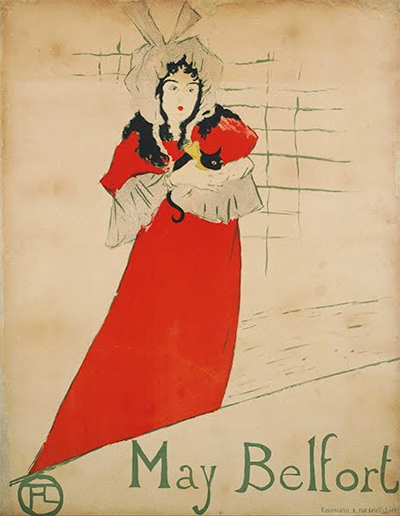Henri de Toulouse-Lautrec, which is the short form for Henri-Marie-Raymonde de Toulouse-Lautrec-Monfa, was born on the 24th of November in 1864 and died on the 9th of September 1901.
He watched and reported with an incredible mental understanding of the characters and features of Parisian nightlife in general and the French universe of entertainment during the 1890s. His utilisation of free-streaming, expressive line, regularly getting to be unadulterated arabesque, brought about exceptionally rhythmical structures. A good example is the famous Circus Fernando: The Ringmaster in 1888). The outrageous improvement in blueprint and development and the utilisation of enormous shading makes his posters a portion of his most dominant works.
May Belfort was an Irish artist who became well known in the Parisian clubs stage because of her silly melodies and her ever-present dark cat, found in Lautrec's limited time poster. The craftsman utilised four separate lithographic stones and special crachis, or scattered ink, to understand the misleadingly basic, intense structure. Aside from his abilities in painting and drawing, Toulouse-Lautrec was likewise a fantastic lithographer and publication craftsman. The may Belfort piece, was delivered to promote the introduction of May Belfort held at a Casino in Paris in the year 1895.
It was an incredible achievement and even won a prize in the next year in the International Poster Exhibition which was held in Rheims. In the art piece, the craftsman mirrors the air of the bistros shows, the Paris nightlife and even the brothels, with a substantial impact from the Japanese artistry that was so popular that time. The high calibre of his posters had a significant effect and turned into a model for the primary experts of this type of imaginative articulation. Lautrec's first expert instructor in painting was the respected René Princeteau, who was a family friend to the Lautrec family.
Princeteau's popularity, for example, emerged from his portrayal of the military and equestrian characters, made in the nineteenth-century scholastic style. Even though Toulouse-Lautrec liked Princeteau, he proceeded onward to the atelier of Léon Bonnat toward the finish of 1882. while there, Toulouse-Lautrec met a craftsman who battled passionately against deviation from academic standards, denounced the slapdash methodology of the Impressionists, and decided for Toulouse-Lautrec's illustration "atrocious." His work got an increasingly positive response in 1883 when he got into the Fernand Cormon studio.
In the mid-1880s, Cormon appreciated a snapshot of VIP, and his studio pulled in such craftsmen as Vincent van Gogh, Émile Bernard and many more. Cormon gave Toulouse-Lautrec many opportunities and freedom to build up an individual style. That Cormon affirmed of his student's work is demonstrated by his picking Toulouse-Lautrec to help him in showing the final release of crafted by Victor Hugo. At last, however, Toulouse-Lautrec's illustrations for this task were not used.
Toulouse-Lautrec made the associate of Bruant, an artist who owned a men's club called the Mirliton. Inspired by his paintings, Bruant approached him to plan posters for his melodies and volunteered the Mirliton as a spot where Toulouse-Lautrec could show his works. Through propagations of his illustrations in Bruant's magazine, he wound up famous in Montmartre and began to get commissions.
Toulouse-Lautrec is most significant for his achievement in going past a portrayal of shallow reality to a firm understanding of the mental state of his subjects. He got into lithograph after 1892 for this objective. Among 300 lithographs delivered in the last decade of his life were a collection of 11 prints called Le Café Concert in 1893; 16 lithographs of performer Yvette Guilbert in 1894; and a progression of 22 representations for Jules Renard in 1899. None of these works is more significant than Elles, which was done in 1896, introducing a touchy depiction of the brothel life. Lautrec spent a lot of time watching the activities and conduct of the prostitutes and their customers as well. The subsequent 11 works uncovered these people as human, with a portion of similar qualities and a significant number of the shortcomings of different individuals from society.
A magnum opus of this kind is "At the Salon". This sketch brings out compassion from the observer as he watches the ladies' detachment and loneliness, characteristics which Toulouse-Lautrec had so regularly experienced himself. It is a splendid exhibit, along these lines, of his expressed want to "portray the genuine and not the perfect," here truth is put together not concerning a cautious portrayal of detail yet instead on catching, in a couple of brief brushstrokes, the basic idea of a subject.
Toulouse-Lautrec enormously affected French craft of the late nineteenth and mid-twentieth century by his utilisation of new sorts of subjects, his capacity to catch the quintessence of a person with efficient methods, and his elaborate advancements. Regardless of his distortion and the impacts of liquor addiction and mental breakdown sometime down the road, Toulouse-Lautrec helped set the stage for cutting edge craftsmanship well past his initial and shocking passing. Followers of this artist may also appreciate the work of Caillebotte and Bazille.




